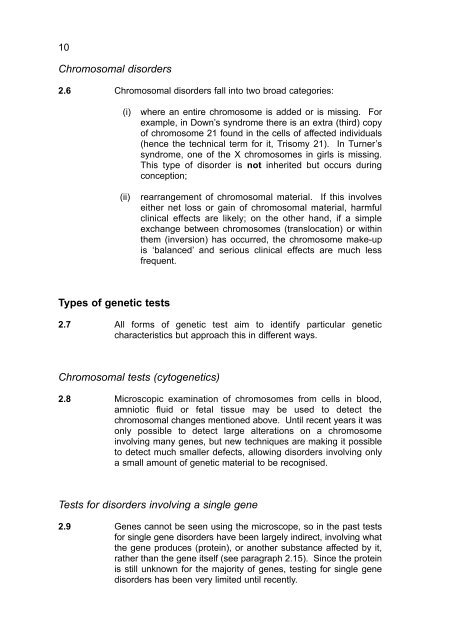Genetic screening: ethical issues - Nuffield Council on Bioethics
Genetic screening: ethical issues - Nuffield Council on Bioethics
Genetic screening: ethical issues - Nuffield Council on Bioethics
You also want an ePaper? Increase the reach of your titles
YUMPU automatically turns print PDFs into web optimized ePapers that Google loves.
10<br />
Chromosomal disorders<br />
2.6 Chromosomal disorders fall into two broad categories:<br />
(i)<br />
(ii)<br />
where an entire chromosome is added or is missing. For<br />
example, in Down’s syndrome there is an extra (third) copy<br />
of chromosome 21 found in the cells of affected individuals<br />
(hence the technical term for it, Trisomy 21). In Turner’s<br />
syndrome, <strong>on</strong>e of the X chromosomes in girls is missing.<br />
This type of disorder is not inherited but occurs during<br />
c<strong>on</strong>cepti<strong>on</strong>;<br />
rearrangement of chromosomal material. If this involves<br />
either net loss or gain of chromosomal material, harmful<br />
clinical effects are likely; <strong>on</strong> the other hand, if a simple<br />
exchange between chromosomes (translocati<strong>on</strong>) or within<br />
them (inversi<strong>on</strong>) has occurred, the chromosome make-up<br />
is ‘balanced’ and serious clinical effects are much less<br />
frequent.<br />
Types of genetic tests<br />
2.7 All forms of genetic test aim to identify particular genetic<br />
characteristics but approach this in different ways.<br />
Chromosomal tests (cytogenetics)<br />
2.8 Microscopic examinati<strong>on</strong> of chromosomes from cells in blood,<br />
amniotic fluid or fetal tissue may be used to detect the<br />
chromosomal changes menti<strong>on</strong>ed above. Until recent years it was<br />
<strong>on</strong>ly possible to detect large alterati<strong>on</strong>s <strong>on</strong> a chromosome<br />
involving many genes, but new techniques are making it possible<br />
to detect much smaller defects, allowing disorders involving <strong>on</strong>ly<br />
a small amount of genetic material to be recognised.<br />
Tests for disorders involving a single gene<br />
2.9 Genes cannot be seen using the microscope, so in the past tests<br />
for single gene disorders have been largely indirect, involving what<br />
the gene produces (protein), or another substance affected by it,<br />
rather than the gene itself (see paragraph 2.15). Since the protein<br />
is still unknown for the majority of genes, testing for single gene<br />
disorders has been very limited until recently.
















